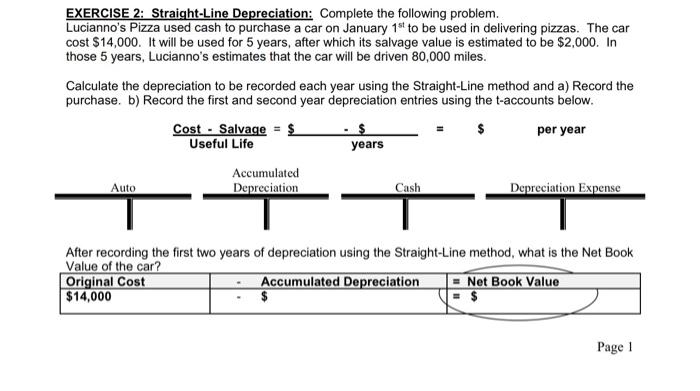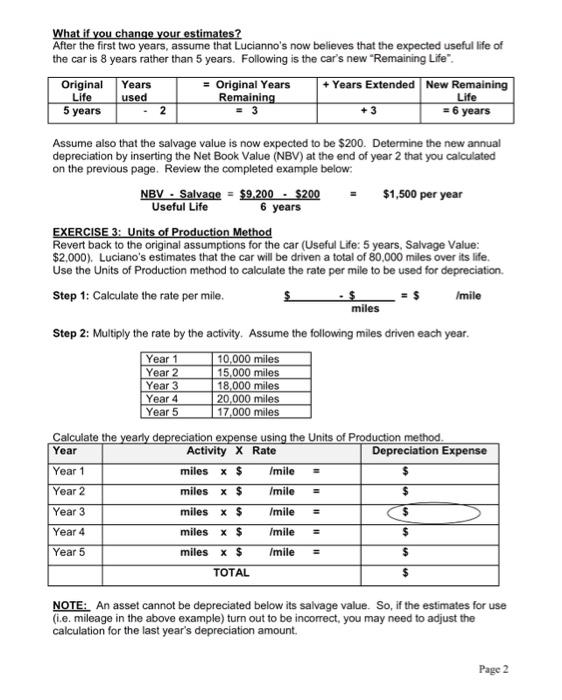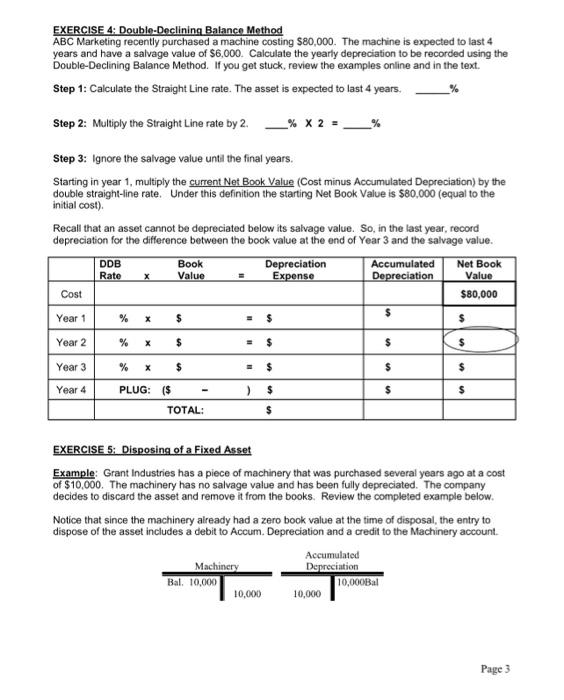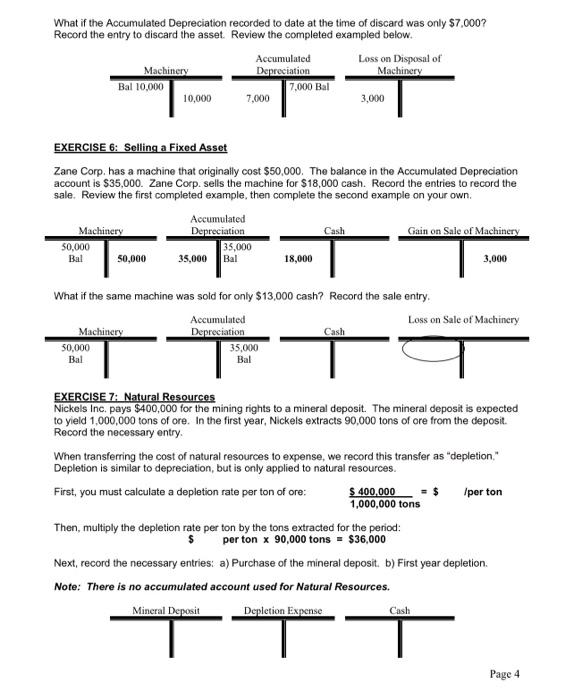Answered step by step
Verified Expert Solution
Question
1 Approved Answer
Only exercises 2, 3, 4, & 6 are needed. EXERCISE 2: Straight-Line Depreciation: Complete the following problem. Lucianno's Pizza used cash to purchase a car




Only exercises 2, 3, 4, & 6 are needed.
EXERCISE 2: Straight-Line Depreciation: Complete the following problem. Lucianno's Pizza used cash to purchase a car on January 1st to be used in delivering pizzas. The car cost $14,000. It will be used for 5 years, after which its salvage value is estimated to be $2,000. In those 5 years, Lucianno's estimates that the car will be driven 80,000 miles. Calculate the depreciation to be recorded each year using the Straight-Line method and a) Record the purchase. b) Record the first and second year depreciation entries using the t-accounts below. After recording the first two years of depreciation using the Straight-Line method, what is the Net Book What if you change your estimates? After the first two years, assume that Lucianno's now believes that the expected useful life of the car is 8 years rather than 5 years. Following is the car's new "Remaining Life". Assume also that the salvage value is now expected to be $200. Determine the new annual depreciation by inserting the Net Book Value (NBV) at the end of year 2 that you calculated on the previous page. Review the completed example below: UsefulLifeNBV-Salvage=6years$9,200$200=$1,500 per year EXERCISE 3: Units of Production Method Revert back to the original assumptions for the car (Useful Life: 5 years, Salvage Value: $2,000 ). Luciano's estimates that the car will be driven a total of 80,000 miles over its life. Use the Units of Production method to calculate the rate per mile to be used for depreciation. Step 1: Calculate the rate per mile. Step 2: Multiply the rate by the activity. Assume the following miles driven each year. Calrulate the vearlv denreciation exnense usina the LInits of Produrtion mathod NOTE: An asset cannot be depreciated below its salvage value. So, if the estimates for use (i.e. mileage in the above example) turn out to be incorrect, you may need to adjust the calculation for the last year's depreciation amount. EXERCISE 4: Doublo-Declining Balance Method ABC Marketing recently purchased a machine costing $80,000. The machine is expected to last 4 years and have a salvage value of $6,000. Calculate the yearly depreciation to be recorded using the Double-Declining Balance Method. If you get stuck, review the examples online and in the text. Step 1: Calculate the Straight Line rate. The asset is expected to last 4 years. Step 2: Multiply the Straight Line rate by 2. %2= Step 3: Ignore the salvage value until the final years. Starting in year 1, multiply the cument Net Book Value (Cost minus Accumulated Depreciation) by the double straight-line rate. Under this definition the starting Net Book Value is $80,000 (equal to the initial cost). Recall that an asset cannot be depreciated below its salvage value. So, in the last year, record depreciation for the difference between the book value at the end of Year 3 and the salvage value. EXERCISE 5: Disposing of a Fixed Asset Example: Grant Industries has a piece of machinery that was purchased several years ago at a cost of $10,000. The machinery has no salvage value and has been fully depreciated. The company decides to discard the asset and remove it from the books. Review the completed example below. Notice that since the machinery already had a zero book value at the time of disposal, the entry to dispose of the asset includes a debit to Accum. Depreciation and a credit to the Machinery account. What if the Accumulated Depreciation recorded to date at the time of discard was only $7,000 ? Record the entry to discard the asset. Review the completed exampled below. EXERCISE 6: Selling a Fixed Asset Zane Corp. has a machine that originally cost $50,000. The balance in the Accumulated Depreciation account is $35,000. Zane Corp. sells the machine for $18,000 cash. Record the entries to record the sale. Review the first completed example, then complete the second example on your own. What if the same machine was sold for only $13,000 cash? Record the sale entry. EXERCISE 7: Natural Resources Nickels Inc. pays $400,000 for the mining rights to a mineral deposit. The mineral deposit is expected to yield 1,000,000 tons of ore. In the first year, Nickels extracts 90,000 tons of ore from the deposit. Record the necessary entry. When transferring the cost of natural resources to expense, we record this transfer as "depletion." Depletion is similar to depreciation, but is only applied to natural resources. First, you must calculate a depletion rate per ton of ore: 1,000,000tons$400,000=$ /per ton Then, multiply the depletion rate per ton by the tons extracted for the period: per ton 90,000 tons =$36,000 Next, record the necessary entries: a) Purchase of the mineral deposit. b) First year depletion. Note: There is no accumulated account used for Natural Resources Step by Step Solution
There are 3 Steps involved in it
Step: 1

Get Instant Access to Expert-Tailored Solutions
See step-by-step solutions with expert insights and AI powered tools for academic success
Step: 2

Step: 3

Ace Your Homework with AI
Get the answers you need in no time with our AI-driven, step-by-step assistance
Get Started


